Out and About in Oslo
by Bob Brooke
In what other European city can you find a dairy farm
within the city limits? That pretty much sums up Oslo, Norway. In
fact, there are also 140 lakes within the city’s boundaries and
enough berries and mushrooms grow in the city to feed most of its
population. And its citizens can go hiking or cycling in the woods
five minutes from the city center.
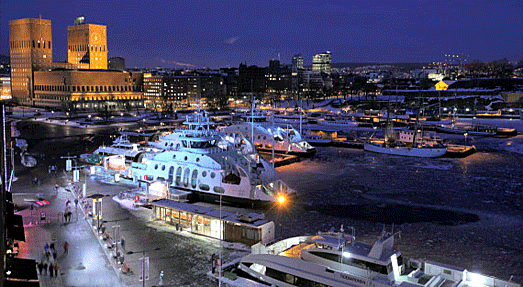
Clustered around the head of the 68-mile-long
Oslofjord, Oslo is probably the most spacious city in the world. Its
175-square-mile metropolitan area consists of over 75 percent
forests and five percent water. Its fine deep harbor, Pipervika,
stretches into the heart of the city and from it leave ferries to
Denmark and Germany.
Twenty percent of Norwegians, more than half a million, live in and
around Norway’s capital. Oslo is Norway's cultural hub, offering a
smorgasbord of historic sights, art, and natural landscapes. The
city offers some of Europe's best museums, a cosmopolitan streetlife,
and easy going lifestyle that allows visitors to relax while taking
in the sights.
History
Oslo is the oldest of the Scandinavian capitals, founded around 1048
by King Harold Hardrade. Six centuries later, after several
devastating fires, Danish King Christian IV moved the city west to
its present location and changed its name to Christiania—after
himself. The new city prospered, and by the time Norway broke with
Denmark in 1814, the citizens of Christiania, as well as the rest of
Norway, wanted independence, which they achieved in 1905. However,
Oslo didn’t get its former name back until 1925.
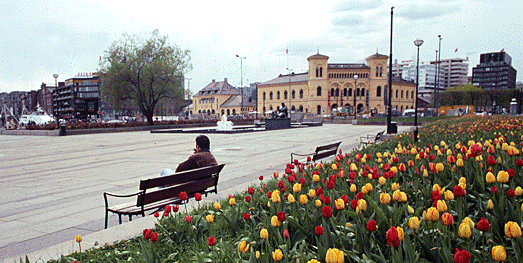
Life in Oslo hums along. You can't help but smell the fragrant aromas
coming from the many
coffee/pastry shops. It has a distinctively
Scandinavian charm. Compared to other European cities, Oslo is
relatively quiet. You’ll hear no blaring horns and pedestrians go
about their business quietly.
All in all, you'll find the city a good-natured kind of place that’s easy to
walk around, with plenty of free sights to see, including the
remains of ancient Viking ships and others that took Norwegians on
far-flung adventures. Norway’s folk culture comes alive at the
open-air folk museum and its heroic spirit is evident at the Nazi
Resistance Museum.
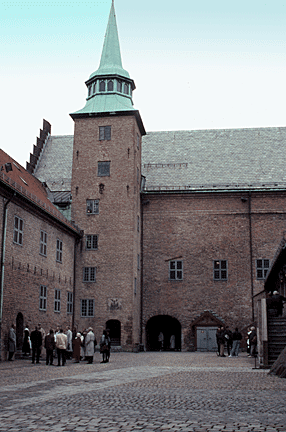 A
good transport system likewise makes it easy for you to get around quickly
if your time is short. And despite the city’s awesome size, it's
difficult to get lost in the city center, running from the railroad
station to the Royal Palace, between the city hall and the harbor.
Through it runs Karl Johans Gate, the central thoroughfare, which
stretches from Oslo’s main train station on its eastern end to the
impressively low-key royal palace in its public parkland on its
western end. A
good transport system likewise makes it easy for you to get around quickly
if your time is short. And despite the city’s awesome size, it's
difficult to get lost in the city center, running from the railroad
station to the Royal Palace, between the city hall and the harbor.
Through it runs Karl Johans Gate, the central thoroughfare, which
stretches from Oslo’s main train station on its eastern end to the
impressively low-key royal palace in its public parkland on its
western end.
Archaeologists have discovered 3,000-year-old rock
carvings on the southern outskirts of the city. Many of the
buildings in its Gamlebyen, or Old Town, east of the Oslo Central
Rail Station, date from the 11th century, including St. Hallvard
Church. Oslo was a backwater, a poor cousin of Copenhagen and
Stockholm until the 1950s when the city remade itself into a
cosmopolitan world capital.
The Akershus Fortress
Rising above the harbor south of the City Hall is one
of Oslo’s oldest buildings, the Akershus Fortress, also known as
Akershus Castle. Its large, empty rooms are stark compared to other
European castles. Behind the chapel altar, steps lead down to the
tombs of some Norwegian kings.
Though very much part of central Oslo, the Akershus Castle, dating
from 1300, with its battlements, towers, ramparts, marching grounds,
stables, prison grounds and cannon, stands on a plateau overlooking
the harbor. The castle was already the veteran of several
unsuccessful sieges when it assumed the role of city defender in
1624. King Christian IV had the castle rebuilt as a Renaissance
castle on the site of the medieval forteress. But despite
restoration, all Norwegians remember it as the Nazi Headquarters
during World War II. Today, it’s the home of the Royal Mausoleum, as
well as the Defense and Resistance Museums, the latter displaying a
moving account of the Norwegian resistance during the Nazi
occupation.
Modern Oslo
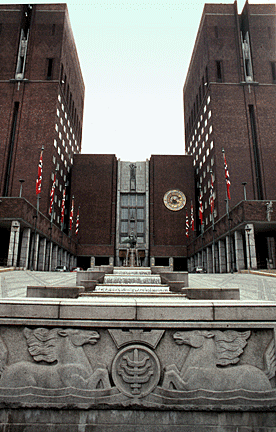 The
modern center of Oslo has wide streets, dignified parks and gardens,
many beautiful, pastel 19th-century buildings, and panoramic vistas.
The centerpiece of the modern city is its richly decorated,
red-brick Rádhuset, or City Hall, begun in 1931 and completed in
1950 to celebrate the city's 900th birthday. Many of Norway's
leading artists, including Sorenson, Rolfsen, and Krohg, and Edvard
Munch, contributed to this avant-garde masterpiece. The building’s
interior features 2,000 square yards of bold and colorful "socialist
modernism" murals that cover the entire history of Norway, right up
to the Nazi occupation. Its main hall celebrates the socialist credo
of "work, play, and civic administration." It’s here each December
that the Nobel Peace Prize award ceremony takes place. Underneath
the Rádhuset’s towers stand six powerful bronze and granite figures
representing the people who worked on the building. Today, the City
Hall’s twin towers stand as a source of civic pride along Oslo’s
waterfront. The
modern center of Oslo has wide streets, dignified parks and gardens,
many beautiful, pastel 19th-century buildings, and panoramic vistas.
The centerpiece of the modern city is its richly decorated,
red-brick Rádhuset, or City Hall, begun in 1931 and completed in
1950 to celebrate the city's 900th birthday. Many of Norway's
leading artists, including Sorenson, Rolfsen, and Krohg, and Edvard
Munch, contributed to this avant-garde masterpiece. The building’s
interior features 2,000 square yards of bold and colorful "socialist
modernism" murals that cover the entire history of Norway, right up
to the Nazi occupation. Its main hall celebrates the socialist credo
of "work, play, and civic administration." It’s here each December
that the Nobel Peace Prize award ceremony takes place. Underneath
the Rádhuset’s towers stand six powerful bronze and granite figures
representing the people who worked on the building. Today, the City
Hall’s twin towers stand as a source of civic pride along Oslo’s
waterfront.
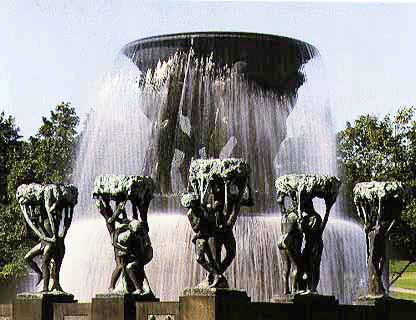 Another
must-see sight of modern Oslo is the 75-acre Frogner Park, which
contains the life’s work of Norway's greatest sculptor,
Gustav Vigeland. From 1924 through 1943, he sculpted 175 bronze and granite
statues. Across a statue-lined bridge rises a huge fountain,
supported by larger-than-life figures. Sculptures surrounding it of
humans intertwined with trees tell the story of mankind. Vigeland's
crowning achievement, and the centerpiece of the park, is his
60-foot-tall tangled tower of 121 bodies called "the monolith of
life." While it seems the lower figures are laden with earthly
concerns, those higher up are free to pursue loftier, more spiritual
adventures. Another
must-see sight of modern Oslo is the 75-acre Frogner Park, which
contains the life’s work of Norway's greatest sculptor,
Gustav Vigeland. From 1924 through 1943, he sculpted 175 bronze and granite
statues. Across a statue-lined bridge rises a huge fountain,
supported by larger-than-life figures. Sculptures surrounding it of
humans intertwined with trees tell the story of mankind. Vigeland's
crowning achievement, and the centerpiece of the park, is his
60-foot-tall tangled tower of 121 bodies called "the monolith of
life." While it seems the lower figures are laden with earthly
concerns, those higher up are free to pursue loftier, more spiritual
adventures.
NOTE: To enjoy
Oslo and save money at the same time, purchase an
Oslo
Pass for free
entrance to all the museums and sights the city has to offer, as
well as free transportation between them.
< Back to Norway
|